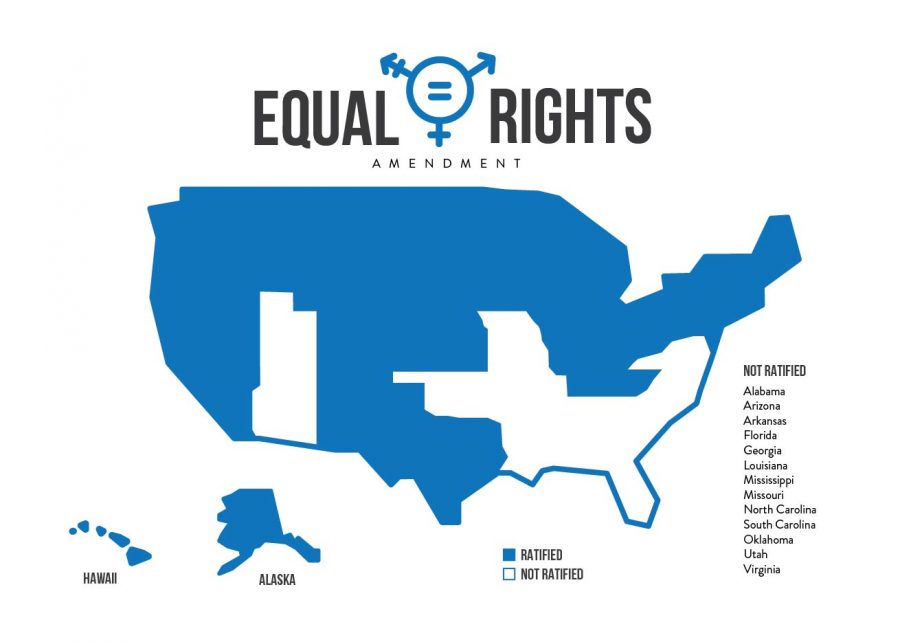Korte: 98 years after its introduction, ratifying the Equal Rights Amendment is long overdue
The Equal Rights Amendment has been ratified by 37 states — one short of the three fourths majority needed to become part of the United States Constitution. Virginia is currently voting on a proposal to ratify the ERA.
Seventy-six percent of constitutions around the world guarantee women’s equality, but the United States Constitution is not one of them. The Equal Rights Amendment (ERA) would change that, but it has languished in the halls of state capital buildings despite being a regular topic of debate since 1921. It’s time we right this wrong and provide women with the full constitutional protections that men have enjoyed for centuries.
I honestly cannot wrap my head around the fact that the ERA has not passed yet. It seems so foundational — so basic. If you’re a woman, you shouldn’t be discriminated against. That’s really all the amendment demands. And yet, here we are in 2019, still fighting state by state — year after year — to put this simple clause into practice.
The ERA is a proposed amendment to the United States Constitution, offering women the highest level of constitutional protections against discriminations on the basis of sex. First introduced to Congress in 1921 by the National Woman’s political party, variations of the amendment were presented to every session of Congress between 1923 and 1970, when the House passed it. The Senate followed suit in 1972.
The passed ERA read, “Equality of rights under the law shall not be denied or abridged by the United States or by any state on account of sex.”
After the ERA passed, it needed to be ratified by three quarters of U.S. states, or 38 states. Thirty states including Kansas did so within a year, but as time went on, anti-ERA activists gained more of a hold in this country and the ratification process lost its momentum. In the 1970s, the ERA became entangled with a variety of other issues besides women’s equality, such as contraception, abortion laws, and gay rights, causing people to turn against it. And the pattern continues.
The deadline for ratifications came and went in 1982, with the number of required approvals coming up three states short. There’s some question as to why a deadline was imposed in the first place. Change takes time and this amendment was never given its due course. If you think about it, it’s quite a feat that 35 states made the leap in a handful of years. Without those last three, however, the amendment was left in a unique situation. It’s kind of tragic actually. So, now what?
Congress has the power to extend or repeal the deadline, to decide if state ratifications subsequent to 1982 are valid, and to accept the ERA as part of the Constitution if 38 states do approve it. With the necessary number of votes, the process could withstand legal challenge and accomplish ratification of the ERA.
There has been much debate over the revival process for the original ERA. But momentum has been building — especially since the 2017 Women’s March on the capital. With the advance of the #MeToo movement, ERA proponents have found a new sense of vigor.
Congressional bills would attempt to remove the deadline or start the whole process over. There are many who question whether the initial deadline was ever constitutional in the first place.
On May 30, 2018, Illinois became the 37th state to ratify the ERA. Today, America needs just one more state to meet the Constitutional requirement for approval.
Now, activists in Virginia are pushing to add their state to the list. On Jan. 9, the Virginia Senate Privileges and Elections Committee voted 8-6 to bring the resolution to the full Senate. The resolution requires passage by the General Assembly. If it does so, Virginia will be the 38th state to ratify the ERA.
But Virginia has been here before, and let the women of this country down. According to the Washington Post, the Virginia Senate passed the ERA five times in the past eight years — most recently in 2016. But each time it passed the Virginia Senate, it languished in the House of Delegates.
Last February, a committee in the Virginia House of Delegates refused to take up the measure, and another panel in the state Senate voted it down with all the no votes being cast by men.
Women and men across the nation need to examine the lengthy battle over the ERA and ask, ‘Is this acceptable?’
Women deserve full constitutional rights. Amending the U.S. Constitution to protect women’s rights nationally is critical for democracy. By not passing the amendment we are essentially moving backward — not standing still and certainly not moving forward.
It’s past time to put pen to paper and ratify the Equal Rights Amendment. Every year that the ERA doesn’t pass, we do more damage to this country and kick dirt in the face of the democratic principles of equality and justice on which this country was founded. My hope is that in 2019, we as a nation will finally have the courage to do what we should have done years ago.
It’s not enough to have a movement, to use a hashtag, or put our fists in the air. We need equality by law. Now.

Audrey Korte was a reporter and the opinion editor for The Sunflower. She hosted The Sunflower News Podcast.








